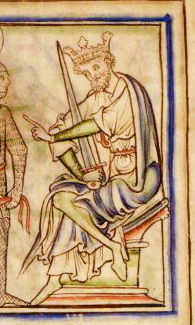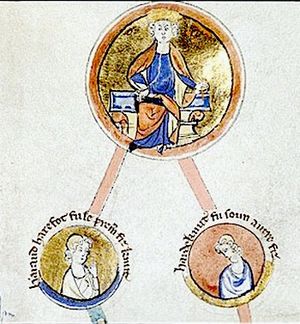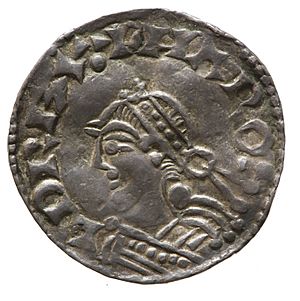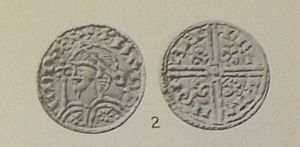Harold Harefoot facts for kids
Quick facts for kids Harold Harefoot |
|
|---|---|

Harold Harefoot in the 13th century The Life of King Edward the Confessor by Matthew Paris
|
|
| King of the English | |
| Reign | 12 November 1035 – 17 March 1040 |
| Predecessor | Cnut the Great |
| Successor | Harthacnut |
| Died | 17 March 1040 Oxford, England |
| Burial | St. Clement Danes, Westminster, England |
| Spouse | Ælfgifu? |
| Issue | Ælfwine? |
| House | Jelling dynasty |
| Father | Cnut the Great |
| Mother | Ælfgifu of Northampton |
Harold I (died 17 March 1040), also known as Harold Harefoot, was King of the English from 1035 to 1040. His nickname "Harefoot" means he was "fleet of foot," like a hare, suggesting he was a fast runner.
Harold was the son of King Cnut the Great and Ælfgifu of Northampton. After his father died in 1035, Harold was chosen to rule England temporarily as a regent. He ruled for his half-brother, Harthacnut, who was stuck in Denmark. Harthacnut couldn't come to England because of problems in Norway.
Even though Harold wanted to be crowned king right away, the Archbishop of Canterbury, Æthelnoth, refused to do it. It wasn't until 1037 that Harold was officially made king, with the support of powerful leaders like Earl Leofric.
In the same year, Harold's two step-brothers, Edward and Alfred, came back to England with an army. Alfred was captured by Earl Godwin, who was loyal to Harold. Alfred was blinded and died soon after from his injuries. Harold Harefoot died in 1040, after ruling for only five years. His half-brother Harthacnut then returned and became king peacefully.
Harold was first buried in Westminster Abbey. However, Harthacnut had his body dug up and thrown into a marshy area near the River Thames. Fishermen later found his body, and it was reburied in a Danish cemetery in London. Eventually, it was buried in a church called St Clement Danes in Westminster.
Becoming King of England
When King Cnut died in November 1035, his son Harthacnut was the rightful heir to the thrones of both Denmark and England. However, Harthacnut couldn't come to England for his coronation. This was because his kingdom in Denmark was threatened by invasions from the kings of Norway and Sweden.
Because Harthacnut was away, England's important leaders decided to make Harold Harefoot a temporary ruler or co-king. This was despite some people, like Earl Godwin, and Queen Emma, being against it. Harold was the only one of Cnut's sons who was in England at the time.
Initially, the Kingdom of England was split between Harold and Harthacnut. Harold ruled the areas north of the River Thames, with support from the local nobles. The southern part of England, under Earl Godwin and Queen Emma, was ruled in Harthacnut's name.
This situation didn't last long. Earl Godwin eventually changed his mind and supported Harold. In 1037, Emma of Normandy, Harthacnut's mother, had to leave England and go to Bruges. After this, Harold was chosen as king everywhere in England.
Historians believe that Harold's mother, Ælfgifu, might have been the real power behind his rule for some time. Harold managed to become king even though Harthacnut had a stronger claim to the throne. This shows that in the 11th century, military power and support from nobles were very important for becoming king.
Events During Harold's Rule
Harold ruled as the only king from 1037 to 1040. Not many records from his reign have survived. Most of the information we have is about church matters, like when bishops and archbishops died or were appointed.
However, there is a record of a small fight between the Anglo-Saxons and the Welsh in 1039. Some important people were killed in this fight, but we don't have many other details. Also in 1039, there was a mention of a big storm, but again, no specific information.
Return of Edward and Alfred
In 1036, Alfred and Edward the Confessor, sons of the late King Æthelred and Queen Emma, came back to England from exile. They brought some soldiers with them. It's not clear why they returned. Some historians think they wanted to claim the English throne for themselves. Others believe Queen Emma might have invited them to use them against Harold.
According to one story, Harold himself tricked them into coming to England. He supposedly sent them a fake letter, pretending to be from their mother, Emma. The letter asked them to come and protect her from Harold. However, many modern historians think this letter might have been real, and Emma was indeed involved.
Alfred planned to visit his mother, Emma, in Winchester. But he was captured by Earl Godwin, who was now supporting Harold. Alfred was taken by ship to Ely and blinded while on board. He died soon after because of his severe injuries. His bodyguards were treated in a similar harsh way. This event later caused problems between Edward and Godwin, as Edward blamed Godwin for his brother's death.
This failed invasion showed that Harold Harefoot had strong support from the Anglo-Danish nobles. These nobles strongly rejected the claims of Alfred and Edward. It also might have been a turning point that led to Queen Emma being sent away from England.
Harold's Death
Harold died in Oxford on 17 March 1040. His death happened just as Harthacnut was getting ready to invade England with an army from Denmark. Harold was first buried at Westminster Abbey.
However, when Harthacnut became king in June 1040, he had Harold's body dug up, beheaded, and thrown into a marshy area next to the River Thames. Fishermen later found the body, and Danish people living in London reportedly reburied it in their local cemetery. Eventually, Harold's body was buried in a church in Westminster, which is now fittingly called St Clement Danes.
The exact reason for Harold's death is not known. Some historians say it was a "mysterious illness." An old English record suggests his illness was a punishment from God. It says Harold was lying ill and sad in Oxford. When monks came to him about a dispute, he "lay and grew black as they spoke." This suggests he died of natural causes, but the exact disease is unknown.
Harold was one of several young kings in England before the Norman Conquest who died after ruling for only a short time. This makes some wonder if being king was very dangerous back then, or if there were hereditary diseases, as many of these kings were from the same family.
Family Life
Harold may have had a wife named Ælfgifu and a son named Ælfwine. Ælfwine later became a monk in Europe. Records from the 1060s mention him as the son of "Harold, who was king of the English People." Harold Harefoot is the most likely father, as the only other King Harold, Harold Godwinson, didn't become king until 1066. Even if Ælfwine was Harold's son, he was too young to claim the throne when Harold died in 1040.
Harold's mother, Ælfgifu of Northampton, disappears from historical records after 1040.
Images for kids
See also
 In Spanish: Haroldo Harefoot para niños
In Spanish: Haroldo Harefoot para niños





